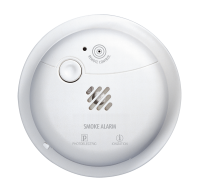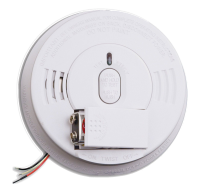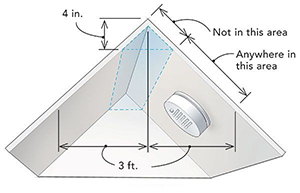Smoke Alarms
It is law in Ontario to have working smoke alarms on every level of your home and outside sleeping areas. You may have seconds to escape a fire in your home. Only working smoke alarms provide those precious seconds you need to escape safely.
Landlords are responsible for ensuring their rental properties comply with the law. Tenants must contact their landlord immediately if they do not have the required number of smoke alarms or if any of the alarms are disconnected or not operating correctly. It is against the law for tenants to remove the batteries or tamper with smoke alarms.
Failure to comply with Ontario Fire Code smoke alarm requirements could result in a ticket up to $360 or a fine up to $50,000 for individuals (first offence) or $500,000 for corporations (first offence).
Replace alarms every 10 years. All models, all types.

Photoelectric smoke alarms
Photoelectric smoke alarms use a beam of light to detect smoke and are most responsive to fires that begin with a long period of smouldering. As a result, they tend to be less prone to nuisance alarms in your kitchen.
Ionization smoke alarms
Ionization smoke alarms detect fire by sensing changes in heat and air quality in your home. They are most responsive to flaming fires but are susceptible to nuisance alarms due to cooking.

Hard-wired smoke alarms
Hard-wired smoke alarms are powered directly by your home’s electricity. Therefore, hard-wired smoke alarms will not function in the event of a power outage. Make sure the alarms have a battery backup feature or install additional battery-operated smoke alarms.
When replacing a hard-wired smoke alarm, you must replace it with another hard-wired unit. You cannot substitute a battery-operated smoke alarm in its place.
Battery-operated smoke alarms
Battery-operated smoke alarms get their power from batteries. Batteries must be replaced when the low battery indicator chirps, when the smoke alarm does not function properly when tested, or every six months.
Smoke alarms are now available with 10-year lithium batteries that do not need to be replaced for the unit's life. These smoke alarms are great for hard-to-reach places and those with difficulty maintaining their smoke alarms.

Interconnected smoke alarms
Interconnected smoke alarms communicate with each other; when one alarm detects fire, they all sound. These smoke alarms give your family the highest level of early warning in the event of a fire. If you have more than one hard-wired smoke alarm in your home, they should already be interconnected.
Wireless interconnected alarms
You can also install interconnected smoke alarms in homes that are not already wired. Wireless smoke alarms are battery-operated and still communicate with each other with wireless signals. These alarms are great for detecting nearby buildings such as a garage or shed.

Smoke alarms with co-alarms
Some smoke alarms are combination units that detect carbon monoxide, smoke, and fire. Combination alarms are available in hard-wired and battery-operated models with two different alarm sounds for smoke or carbon monoxide.
Detector special features
Since it is against the law to disable smoke alarms, many smoke alarms are now available with features such as hush buttons that temporarily silence a nuisance alarm.
Additionally, smoke alarms are available with strobe lights, pillow and bed shakers, and other notifiers for those who are hearing or visually impaired.
In Ontario, working smoke alarms are required by law on every level of the home and outside all sleeping areas. New homes are also required to have a working smoke alarm equipped with a visual signal device, like a flashing strobe light, inside each bedroom.

Ceiling and wall placement
Smoke rises and smoke alarms should be located up high, either on a ceiling a minimum of four inches away from a wall or on a wall between four to 12 inches down from the ceiling. Smoke alarms must be installed in accordance with the manufacturer’s guidelines, but this graphic can be used as a guideline for where to place them.

Peaked or sloped ceilings
In rooms with peaked or sloped ceilings, you should install smoke alarms near the top of the ceiling. They should be at least four inches down but must be placed within three feet of the peak measured horizontally. Smoke alarms must be installed on peaked or sloped ceilings in accordance with the manufacturer’s guidelines, but this graphic can be used as a guideline for where to place smoke alarms in rooms with peaked or sloped ceilings.
Resources
For information on installing and maintaining your smoke alarms, planning your escape, handling nuisance alarms, and more.
Contact
- 400 East Main St., Welland, ON L3B 3X5
- Emergencies, including fires, smoke, fireworks: 911
- Main: 905-735-1700 x7
- fire@welland.ca
- Fire Safety Concerns and Report Requests: 905-735-1700 x2488
- fireprevention@welland.ca
- /WellandFire
- /WellandFire
- /WellandFire